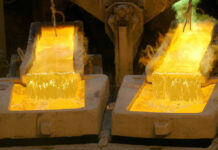
ALPHAMIN, the Toronto-listed company developing the Bisie tin project in the Democratic Republic of Congo (DRC), expected to close an $80m fund-raising programme next week ahead of raising a further $50m through the issue of company shares.
“We’re focusing our energy on getting the debt complete, and as soon as that is done, we will then start a more formal engagement process to close the book out,” said Boris Kamstra, CEO of Alphamin. He would not disclose the firm’s lenders.
The total cost of the Basie project is estimated to be $152m towards which Alphamin had already raised $22m in July through private share placements.
Speaking at a presentation in August, Kamstra said that, all going to plan, initial production of tin-in-concentrate from Bisie is expected during the first quarter of 2019 with the underground mine forecast to reach steady state production by the end of that year.
The mine is expected to produce an estimated 9,600 tonnes of tin-in-concentrate annually with an initial life-of-mine of 12.5 years. Average EBITDA (earnings before interest,tax,depreciation and amortization) from the mine is estimated at around $110m, meaning the payback period on the project is less than two years.
The project is controlled through an Alphamin operating subsidiary in the DRC in which Alphamin holds 80%; South Africa’s Industrial Development Corporation has a 15% stake and the DRC government owns 5%. The mine is expected to be in the lowest cost quartile of all tin producers.
Kamstra would not be drawn on whether the upcoming equity capital raise would involve a listing on the Johannesburg Stock Exchange. “I have no ideas whether it will or won’t be done through the JSE listing,” said Kamstra. “It will depend on where we see the weight of interest is coming from”.
Kamstra said Alphamin had had “exceptional support” from the North Kivu government for the project and particularly in dealing with artisanal and illegal miners in the region which at one stage had numbered up to 15,000 in 2008/2009, but had now dropped to around 400. These remaining miners would be moved to a site near to Bisie where they could continue with their activities.











